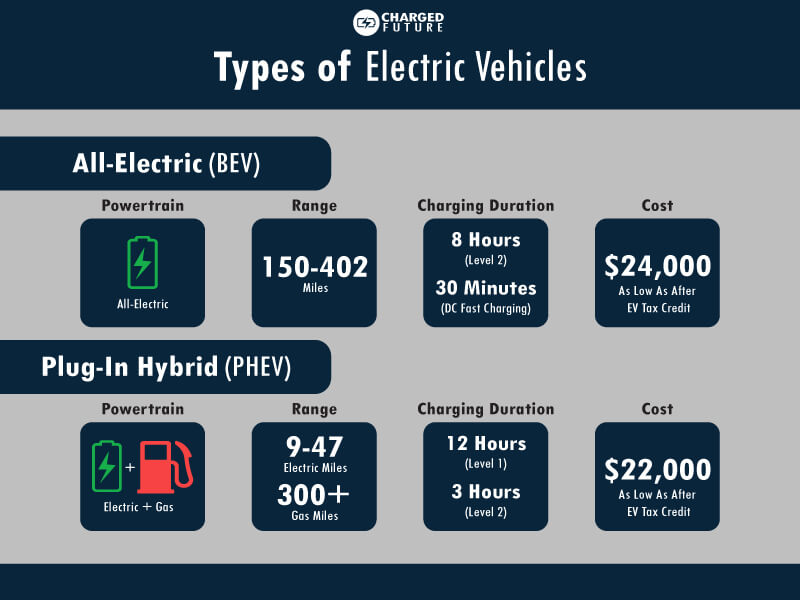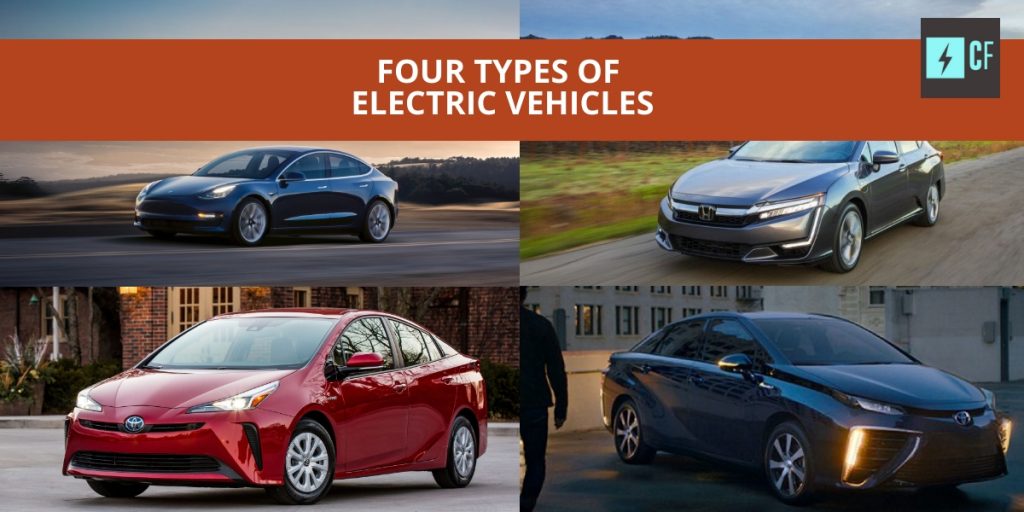There are four types of electric vehicles: Battery Electric Vehicle (BEV), Plug-in Hybrid Electric Vehicle (PHEV), Hybrid (HEV), and Hydrogen Fuel Cell. Each type varies greatly in range, charging and/or refueling cost, and engineering & design. While each has its pros and cons, you may find more than one type of electric vehicle right for you.

Battery Electric Vehicle (BEV)
A BEV is more commonly known as “full”, “pure”, or “all” electric. This type of electric vehicle has a large rechargeable battery on-board that provides all the energy the car needs to propel forward. Common examples include the Tesla Model 3, Chevy Bolt, and Nissan Leaf.

Image credit: Tesla
Range, Charging, and Efficiency
Most BEVs today BEV provide 200+ miles of range via a 60-100 kWh battery pack. The battery is rechargeable not only from regenerative braking (energy sent back to the battery from braking rather than the use of friction brakes) but also from Level 1 and Level 2 AC charging and DC Fast Charging. The battery is capable of charging from 10% to 80% in about 30 minutes with DC Fast Charging.
In terms of efficiency, a BEV is superior to all other mass-marketed vehicles. For example, Tesla Model 3 has an EPA efficiency rating of 130 MPGe. MPGe stands for Miles Per Gallon Equivalent. Without getting too technical, it is the EPA’s way of determining the efficiency of an EV by using the same metric that we use for ICE (Internal Combustion Engine) vehicles (or gas) cars.
By comparison, the once ultra fuel sipper Toyota Prius is 60% less efficient. In other words, a typical all-electric car is 160% more efficient than a regular hybrid. The case builds even more when you compare an average gas car of 25 MPG. In that scenario, the BEV is 420% more efficient!
Cost
The cost of BEVs can range from $30,000 to $100,000. While that is a very large spread, popular BEVs like the Model 3 or Bolt start under $40,000. In addition to state, local, and utility incentives, BEVs are eligible for the $7,500 Federal Electric Vehicle Tax Credit.
It is important to note the Federal Government limits the tax credit to manufacturers within the 200,000 electric car sales ceiling. As of today, only Tesla and GM have reached that threshold and are no longer eligible for the tax credit. Other incentives do not have similar restrictions.
There are three different speeds to charge a BEV: Level 1, Level 2, and Level 3 (more commonly known as DC Fast Charging or DCFC). Level 1 utilizes a regular household outlet. Because the battery is very large on a BEV, it would take days to fully charge. Some drivers use Level 1 charging to replenish the daily commute overnight since it can recharge about 50 miles overnight.
Level 2 charging utilizes a 240-volt outlet, like an electric dryer. At this speed, a BEV can be fully recharged in about 8 hours.
Lastly, there is DCFC. This can relatively quickly charge a BEV from 10% to 80% in 30 minutes. You can learn more about charging at the two part article series on charging. How to Charge an Electric Vehicle: Part 1. How to Charge an Electric Vehicle: Part 2.
| Charge Time | BEV | PHEV |
| Level 1 (120 Volt “Regular Outlet”) | 30+ hours | 12 hours |
| Level 2 (240 Volt) | 8 hours | 4 hours |
| DC Fast Charge | 30 minutes | N/A |
Plug-in Hybrid Electric Vehicle (PHEV)
A PHEV is a middle ground between a BEV and a conventional hybrid. This type of electric car uses both an on-board, rechargeable battery, and gasoline fuel tank to move the vehicle. The battery can be recharged by plugging in or via regenerative braking.
Range, Charging, and Efficiency
The battery, while large in comparison to other batteries like those found in cell phones or laptops, is much smaller than a BEV. A typical PHEV will have a battery of about 10-15 kWh, which provides around 20-40 miles of electric range. After the battery is depleted, the gas backup kicks in for another 300+ miles. In other words, a PHEV operates in all-electric mode for in-town trips or work commutes and in gas mode for long trips or vacations. This is why many consider the plug-in hybrid the best of both worlds.
Most PHEVs have an EPA rating of 100 MPGe and 40 MPG. They have two different ratings for each driving mode: electric and gas. As you can tell, the PHEV bridges the gap between a BEV and a regular hybrid. It is not as efficient as the BEV, however, it is much more efficient than a conventional hybrid.
Cost
Due to the smaller battery pack, PHEVs cost less than the all-electric BEV. A non-luxury PHEV costs around $25,000 to $35,000. Like BEVs, the plug-in hybrid is eligible for the federal EV tax credit. Depending on the battery size and manufacturers EV sales, buyers can claim up to $7,500 in tax credits.
This can bring the net purchase price down to as low as $22,500. As noted in previous articles like the 2020 Honda Clarity PHEV vs Accord or 2020 Toyota Prius vs Prius Prime, after the tax credit a PHEV can cost less than typical gas or hybrid. The case is even more so with the additional state, local, and utility rebates.

Image credit: Honda
Since the plug-in hybrid has two sources of energy (electric and gas), it can be recharged and refueled. PHEVs, like BEVs, can be charged via Level 1 and Level 2 charging. Since the battery is not as large as a BEV and because there is a gas backup, there is no need for DCFC. You can also refuel a PHEV just like the conventional gas car.
Hybrid Electric Vehicle (HEV)
The third type of electric vehicle isA hybrid electric vehicle (HEV), or technically called “mild” or “soft” hybrid, combines both an on-board, non-rechargeable battery and a gasoline fuel tank. A big distinction between a regular hybrid and a plug-in hybrid is, well, in the name.
As stated previously, a PHEV can be recharged by plugging into a power source or by regenerative braking. A PHEV can also operate solely on electric power. On the other hand, a regular hybrid cannot be recharged by plugging in. Additionally, a hybrid must always have gas in the tank to operate.
The conventional hybrid has a much, much smaller battery than a PHEV and BEV. This battery can be recharged by regenerative braking, but, again, must still use gas as well.
As you may know, a typical hybrid, like the Toyota Prius, can achieve 50 MPG. That is certainly impressive when compared to other standard ICE cars that only get 25 MPG. However, as discussed previously, is not as great when compared to a BEV or even a PHEV. Still, for those not ready for the plug-in electric car, a hybrid is the next best bet.

Conventional hybrids are fairly competitive to standard ICE vehicles. Something like the Toyota Prius can be purchased for less than $25,000. It is important to point out again that a much more efficient PHEV can cost less after tax credits are considered.
Hydrogen Electric Vehicle (Fuel Cell)
The HEV is the least common type of electric vehicle. With sales in the mere hundreds per month, hydrogen fuel cell vehicles are not much worth discussing.
In brief, a hydrogen fuel cell can travel 300 miles on a single tank of hydrogen. Refueling the fuel cell takes about 10 minutes.
Sound great so far? It is until you know about the vehicle cost and the number of hydrogen stations. There are only a few hydrogen fuel cells sold in the U.S. The most common one is the Toyota Mirai. The Mirai costs $58,000. There are EV incentives like with the BEV or PHEV. Efficiency wise these types of electric vehicles get around 66 MPGe.

Image credit: Toyota
Refueling stations are probably the biggest bane for fuel cells. There are only a few dozen stations across the U.S. This means owners of a fuel cell are strictly tethered to a 150 mile range of one of these stations before needing to turn back. The reason there are few hydrogen stations is that the cost to make and store hydrogen at these stations is just too expensive for companies to invest in.
Closing Thoughts:
Out of the four types of electric vehicles, the BEV (all-electric, the PHEV (plug-in hybrid), and the HEV (regular hybrid) are the most common. In addition, these electric vehicles will save you thousands of dollars over the years of ownership compared to a regular ICE vehicle. This is because of the better efficiency EVs have.
Specifically, BEVs and PHEVs are the most efficient. As aforementioned, BEVs can have an MPGe of 120! The high level of efficiency is why all-electric vehicles can have a lower total cost of ownership compared to a gas car despite a higher purchase price. For those who are not ready to take on the full-electric lifestyle, a plug-in hybrid may be a better fit for you.
That is the choice my wife and I made with our Chevy Volt. We can honestly say it has been the best of both worlds–high efficiency and no range anxiety.
If you’re curious about which plug-able EV is right for you, check out the Comprehensive Electric Car List. You can also download it as a PDF by signing up for the free monthly newsletter!

Hi there! I’m the founder and project manager at Charged Future: the EV charging consultancy. Charged Future helps businesses achieve their EV charging goals. Specifically, I serve as the project manager for your EV charging project, which can save you both time and money! Additionally, I can search and apply to all eligible rebate applications, which can typically cover a large portion of the project cost.


